What does “kinoko” mean in Japanese?
Native speakers say “kinoko” to mean ‘mushroom’ in Japanese. Perhaps, some Japanese learners know this word as it is sometimes used in Japanese video games, manga, anime, and the like. In this blog post, however, I will explain this word in detail together with its kanji expressions. And also, I will explain how to use it through example sentences. My explanations would help Japanese learners understand “kinoko” more clearly. Then, let’s get started!
Contents
Definition and meaning of “kinoko”
Let me start with the definition and meaning of “kinoko”.
- kinoko – 茸 (きのこ) : a noun meaning ‘mushroom’ in Japanese. This can also work as plural. Learn more about Japanese plural.
Interestingly, Japanese has different names for different mushrooms. Normally, Japanese native speakers say “kinoko” to refer to mushrooms in general.
The definition and meaning are simple and clear. To understand this noun more clearly, however, let me explain its original kanji expression in detail.
What did “kinoko” originally mean in Japanese?
It is said that the original kanji expression of “kinoko” was “木の子”. This consists of the following three characters:
- 木 : a kanji character widely used to mean ‘tree’ in Japanese.
- の : a case particle joining two nouns. Normally, the first one can work as a modifier to describe the second. In this case, this works to join “ki” and “ko”.
- 子 : a kanji character widely used to mean ‘child’ or ‘kid’ in Japanese.
These three characters tell us that “kinoko” literally meant “trees’ children” in Japanese. This literal interpretation is not completely in line with the actual meaning, but still understandable, I think. Some mushrooms indeed look like small trees.

When we meet new kanji expressions, we should check their kanji characters in detail to understand their meanings clearly and deeply. In many cases, kanji characters tell us a lot about the meanings of the expressions they form. Actually, here, we could get the better understanding of “kinoko” through the detailed check above.
So far, I’ve explained the definition and meaning of “kinoko” together with its kanji expressions. Then, let me explain how to use it through the example sentences below.
Example #1: how to say “mushrooms” in Japanese
watashi wa yoku kinoko wo tabe masu – 私はよく茸を食べます (わたしはよくきのこをたべます)
I often eat mushrooms.
Below are the new words used in the example sentence.
- watashi – 私 (わたし) : a pronoun meaning ‘I’ in Japanese.
- wa – は : a binding particle working as a case marker or topic marker. In the example, this works after “watashi” to make the subject in the sentence.
- yoku – よく : an adverb of frequency meaning ‘often’ in Japanese.
- wo – を : a case particle used to make the object word in a sentence. In the example, this is used after “kinoko” to make the object in the sentence.
- tabe – 食べ (たべ) : one conjugation of the verb, “taberu“, which means ‘to eat’ in Japanese. In the example, it has been conjugated for the better connection with its following word.
- masu – ます : an auxiliary verb used after a verb to make it sound polite. Probably, this is well known as a part of Japanese masu form. In the example, this is used after “tabe” to make it sound polite.
This is a typical usage of “kinoko”. In this example, it works together with the case particle, “wo”, to become the object in the sentence.
Example #2: another usage of “kinoko”
nihonjin wa kinoko ga suki desu – 日本人は茸が好きです (にほんじんはきのこがすきです)
Japanese people love mushrooms.
Below are the new words used in the example sentence.
- nihonjin – 日本人 (にほんじん) : a noun meaning ‘Japanese people’ in Japanese.
- ga – が : a case particle used to make the subject word or the object word in a sentence. In the example, this is used after “kinoko” to make the object in the sentence.
- suki – 好き (すき) : the stem part of the na-adjective, “sukina”, which means ‘favorite’ in Japanese. Native speakers, however, often use this as an individual word to mean ‘to like’ or ‘to love’ in Japanese. In the example, this is used to mean ‘to love’.
- desu – です : an auxiliary verb used after a noun or adjective to make it polite. Probably, this is well known as a part of Japanese desu form. In the example, this is used after “suki” to make it sound polite.
This is another typical usage of “kinoko”. In this example, it works together with the case particle, “ga”, to become the object in the sentence. When we want to refer to mushrooms in Japanese, anyway, this noun is always a very good option.
Summary
In this blog post, I’ve explained the definition and meaning of “kinoko” in detail together with its kanji expressions. And also, I’ve explained how to use it through the example sentences. Let me summarize them as follows.
- kinoko – 茸 (きのこ) : a noun meaning ‘mushroom’ in Japanese. This can also work as plural. It is said that the original kanji expression of this noun was “木の子”. These three characters literally mean “trees’ children” in Japanese. This literal interpretation is not completely in line with the actual meaning, but still understandable, I think. Some mushrooms indeed look like small trees.
Hope my explanations are understandable and helpful for Japanese learners.